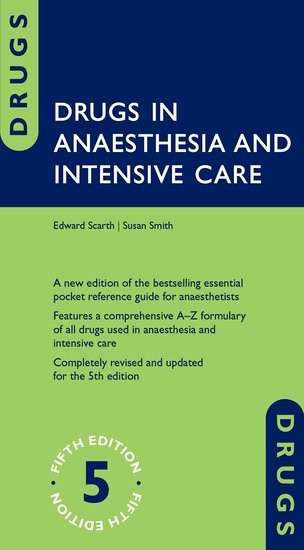Authors: Edward Scarth, Susan Smith
Sairah Sadaf
Assistant Professor, Department of Anesthesiology & Intensive Care, Sheikh Zayed Medical College/ Hospital, Rahim Yar Khan (Pakistan); E-mail: sairahbabar@live.com

The sophisticated and multiplex specialty like Critical care and anesthesia necessitates a sheer need for some single best pocket companion for their working personnel to aid them in rapid access to comprehensive knowledge and authentic references at the spot. In swarming environment of advanced gadgets and millions of books around, it’s really exasperating and time consuming to embark upon some single best solution.
“Drugs in Anesthesia and Intensive care” is one such good addition among handbook series of Oxford publishers which has had proved to be a rapid source of invaluable information for both anesthetists and intensivists in their customary professional conduct. It reflects the coordinated hard work orchestrated by two dedicated Anesthesia consultants Edward Scarth and Susan Smith, currently working in UK, who came up with this handy source of information. This 5th edition is an improved sequel of their previous work, based on its original format, comprising 184 important as well as essential drugs with the addition of comparative drug tables at the end, leaving almost no domain of pharmacological medicine. Drugs are systematically structured and organized in sections, like uses, chemical structure, presentation, main action, mechanism of action, route of administration, doses, pharmacodynamics, side effects, kinetics and most importantly the special points regarding each drug. It’s simple alphabetical ‘A-Z’ style and user friendly configuration makes it more efficient and palatable as are its other competitors for its intended readers to cite a drug easily and rapidly. As this is a revised edition so some drugs are removed which are no more in common use while some new additions are made.
Short comings: as mentioned by the authors in the preface of this book, the basics of pharmacology are not included in this book, because they intended to complement rather to replace the standard text books of pharmacology of anesthesiology. In this context, the assertion made by authors that it will be of value for students appearing in written and oral parts of FRCA seems to be an embellishment here, while rest of the claim is achieved successfully. Secondly, my standpoint is that more tabulated comparisons of drugs belonging to same group should be drafted in the last section, thus making learning more serene and effortless for students.
As a whole, I think the main aim of writing this book is well conveyed to the intended readership and it’s an utter contribution to quick learning, academic training and inflicting knowledge in the concomitant field.
Price: $59.95
Flexicover; 448 Pages; 7.1 x 3.9 inches
ISBN: 9780198768814
Publisher: Oxford University Press, University of Oxford. United Kingdom




 Facebook
Facebook Twitter
Twitter GooglePlus
GooglePlus Youtube
Youtube